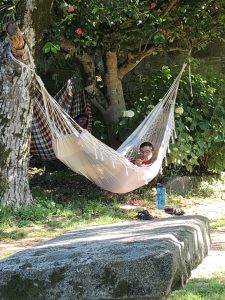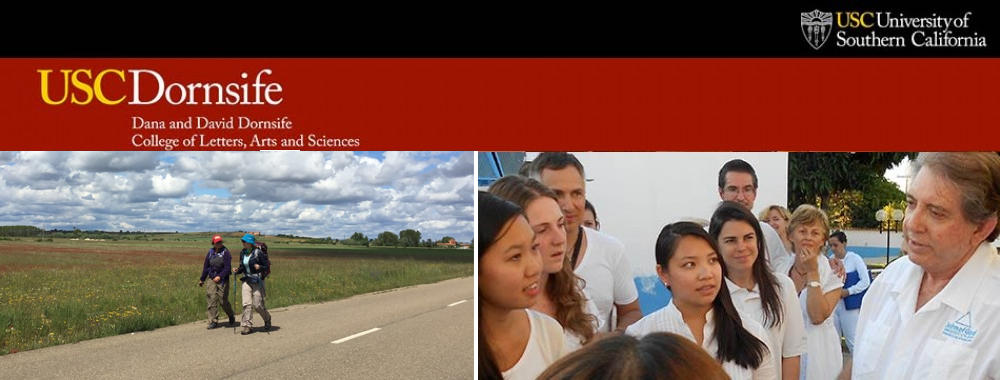 Liminality, as first defined by anthropologist Victor Turner, is a process of being in-between. Having left a previously held structure, the person then exists in an area of ambiguity until their rite of passage, journey, or pilgrimage is complete. Turner would argue that most pilgrims exist in that liminal space. It is how we as a class have existed for the length of our journey – walking for two weeks from place to place, never quite finding structure or finality. However, contrary to Turner’s definition, many pilgrims do not always find themselves in this liminal space for the extent of their pilgrimage. Many have walked the Camino multiple times, incorporating it repeatedly into their lives. I met a man from Colorado who was on his fifth Camino – since he’s retired this has become his yearly routine. Even more extreme is the case of a Dominican monk from Poland, who claims to have gone on the Camino six different times with different groups of students. While on the pilgrimage he provides them with a daily mass, leadership, and guidance. For these people, the pilgrimage has become a routine, something they do time and time again, year after year. I would argue that these people still exist in liminality – after all, they are on the move without a structured sense of here or there. But the Camino has also become a type of structure for them, putting them at an interesting in-between. From these pilgrims, it would be simple to assume that pilgrimage necessitates some degree of liminality; however, in certain cases it can provide a deep and permanent structure. Such is the case with Rita, an Irishwoman who runs a pilgrimage house with her husband Matthew. For Rita, her pilgrimage started much earlier than the Camino – leaving her job and life behind at twenty-one to travel to Amsterdam and escape her current structure. In Amsterdam, she met a man who invited her into the church community located there, where she eventually found structure and a return to her faith in God. Now, she runs a pilgrim hostel in which she gifts a part of her experience unto others, making a safe, clean place for many pilgrims to relax, rest their aching feet, and spend the night. Pilgrimage for her is no longer a liminal space per Turner’s definition – there is no real in-between and she has long since completed any specific rite of passage. The Camino has instead become a structure on which she has built the foundation of her life. Thus, as the pilgrim saying goes, “The Camino provides”. A freedom and ambiguity for first time walkers, a consistent adventure for returning pilgrims, and even a sense of permanent community.
Liminality, as first defined by anthropologist Victor Turner, is a process of being in-between. Having left a previously held structure, the person then exists in an area of ambiguity until their rite of passage, journey, or pilgrimage is complete. Turner would argue that most pilgrims exist in that liminal space. It is how we as a class have existed for the length of our journey – walking for two weeks from place to place, never quite finding structure or finality. However, contrary to Turner’s definition, many pilgrims do not always find themselves in this liminal space for the extent of their pilgrimage. Many have walked the Camino multiple times, incorporating it repeatedly into their lives. I met a man from Colorado who was on his fifth Camino – since he’s retired this has become his yearly routine. Even more extreme is the case of a Dominican monk from Poland, who claims to have gone on the Camino six different times with different groups of students. While on the pilgrimage he provides them with a daily mass, leadership, and guidance. For these people, the pilgrimage has become a routine, something they do time and time again, year after year. I would argue that these people still exist in liminality – after all, they are on the move without a structured sense of here or there. But the Camino has also become a type of structure for them, putting them at an interesting in-between. From these pilgrims, it would be simple to assume that pilgrimage necessitates some degree of liminality; however, in certain cases it can provide a deep and permanent structure. Such is the case with Rita, an Irishwoman who runs a pilgrimage house with her husband Matthew. For Rita, her pilgrimage started much earlier than the Camino – leaving her job and life behind at twenty-one to travel to Amsterdam and escape her current structure. In Amsterdam, she met a man who invited her into the church community located there, where she eventually found structure and a return to her faith in God. Now, she runs a pilgrim hostel in which she gifts a part of her experience unto others, making a safe, clean place for many pilgrims to relax, rest their aching feet, and spend the night. Pilgrimage for her is no longer a liminal space per Turner’s definition – there is no real in-between and she has long since completed any specific rite of passage. The Camino has instead become a structure on which she has built the foundation of her life. Thus, as the pilgrim saying goes, “The Camino provides”. A freedom and ambiguity for first time walkers, a consistent adventure for returning pilgrims, and even a sense of permanent community.
The Global Performance of Healing: Spain and Brazil
